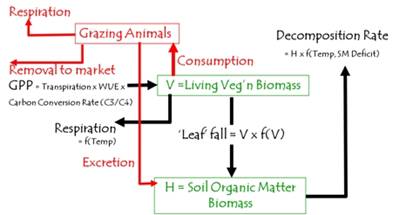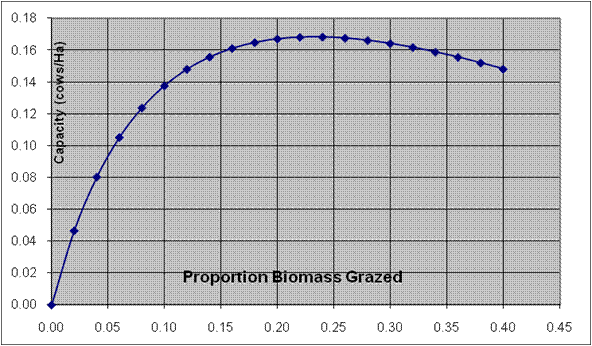Grazing
Grazing animals consume vegetation, removing a significant fraction of the primary production. Although a fraction of this consumption (c 10%) is returned locally as solid or liquid excretion, there is a net loss of biomass (including carbon and nitrogen) from the system, much of it returned to the atmosphere as CO2 or CH4 (methane) and about 10% converted to body tissue and finally transferred to market. Under equilibrium conditions there is thus a fairly constant ratio between biomass consumed and the carrying capacity of the land, with transitional states where there is a change in grazing intensity.

Figure 2.1. Inclusion of grazing animals within the carbon cycling scheme in PESERA
The approach adopted in PESERA has been to specify the fraction of the plant biomass that is consumed each month, which can range from 0 to 100%. This has been preferred to setting the number of grazing animals, as it prevents the possibility of consuming more biomass than is present at any time. As a result the carrying capacity changes through the year, and this can be interpreted in at least three ways; first by considering that the carrying capacity is set by the minimum month, second as a basis for estimating supplementary fodder requirements for the leaner months and thirdly through transhumance, so that grazing only takes place when material is available.
When this approach is implemented in PESERA, we see an interesting relationship between grazing intensity and carrying capacity, illustrated for Senegal (Ferlo) in figure 2.2. At low grazing pressures, increased consumption allows higher carrying capacities but, beyond an optimum, the increased grazing reduces the biomass so much that carrying capacity falls, setting a clear point beyond which the area can be described as 'over-grazed'.
The work described here has been performed to serve both the DeSurvey and DESIRE projects. Corresponding to the resources available and the timig of the projects, the majority of this work on grazing (70%) has been supported by DeSurvey, but have been taken further to provide for the management needs identified in DESIRE.

Figure 2.2. Relationship between proportion of biomass grazed and carrying capacity (cattle equivalents per hectare: 1 cow ~ 3 sheep/goats)
Changing intensity of grazing and changes in fuel wood harvesting are listed above as one of the mitigation strategies to be adopted. Since fuel wood harvesting can also be seen as a removal of a fraction of the biomass, these two strategies can both be modelled through the approach outlined above, modifying the code to recognise that a part of the biomass removed is assigned to animal grazing and another part to fuel wood collection. The intensities of removal may be linked to location - access to water for grazing and proximity to cities and roads for fuel wood collection. Game ranching can also be treated in this way, assigning the carrying capacity to the game herd instead of to domestic animals, and there may again be a need to recognise trans-humance behaviour, seeking high seasonal carrying capacities along an annual migratory track.